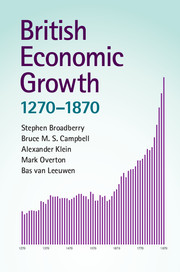Book contents
- Frontmatter
- Contents
- List of Tables
- List of Figures
- List of Appendices
- Preface and acknowledgements
- List of Weights, measures and money
- Prologue: Historical national income accounting
- Part I Measuring economic growth
- Part II Analysing economic growth
- 6 Real wage rates and GDP per head
- 7 Consumption
- 8 The social distribution of income
- 9 Labour productivity
- 10 Britain in an international context
- 11 Epilogue: British economic growth, 1270–1870
- Bibliography
- Index
7 - Consumption
Published online by Cambridge University Press: 05 January 2015
- Frontmatter
- Contents
- List of Tables
- List of Figures
- List of Appendices
- Preface and acknowledgements
- List of Weights, measures and money
- Prologue: Historical national income accounting
- Part I Measuring economic growth
- Part II Analysing economic growth
- 6 Real wage rates and GDP per head
- 7 Consumption
- 8 The social distribution of income
- 9 Labour productivity
- 10 Britain in an international context
- 11 Epilogue: British economic growth, 1270–1870
- Bibliography
- Index
Summary
Introduction
Chapter 6 has argued that workers responded to changes in real wage rates by adapting how hard they worked so as to maintain their earnings. Household incomes therefore tracked GDP per head rather than real wage rates and progressively improved over time, doubling between the early fourteenth and late seventeenth centuries and doubling again over the course of the industrial revolution. Higher incomes translated into changing patterns of consumption and the forms these consumption choices took are the subjects of this chapter. Section 7.2 reconstructs the kilocalorie value and composition of diets based on the agricultural-output estimates presented in Chapter 3, augmented by information on imported foodstuffs. Given that populations require an average daily food intake per head of 2,000 kilocalories (Livi-Bacci, 1991: 27) to provide sufficient nourishment for both economic and biological reproduction, these calculations also provide a useful cross-check on the consistency of the agricultural-output and population estimates. Section 7.3 then considers non-food consumption drawing upon early modern evidence of material culture as revealed by probate inventories. Again, these trends need to be consistent with those of industrial output reconstructed in Chapter 4.
Price, habit, fashion and status all shaped the budgetary decisions taken by households. Demand for food was inelastic up to the point where basic subsistence needs had been met, but as incomes rose there were clear trade-offs to be obtained between increasing consumption of cheap sources of kilocalories such as pottage, potatoes and salted herrings on the one hand, or indulging in more expensive refined bread, quality ale and beer, dairy produce and meat, plus the imported luxuries of wine, sugar, tea, cocoa and tobacco, on the other. In effect, higher incomes allowed more households to trade up to a respectability basket of foodstuffs providing a more varied and processed diet but not necessarily more kilocalories. The changing relative prices of arable, livestock and luxury products influenced these consumption decisions, while the relative cheapness or dearness of food determined how much disposable income could be devoted to the increasingly varied and tempting array of non-food consumer goods (Figure 5.02).
- Type
- Chapter
- Information
- British Economic Growth, 1270–1870 , pp. 279 - 306Publisher: Cambridge University PressPrint publication year: 2015



